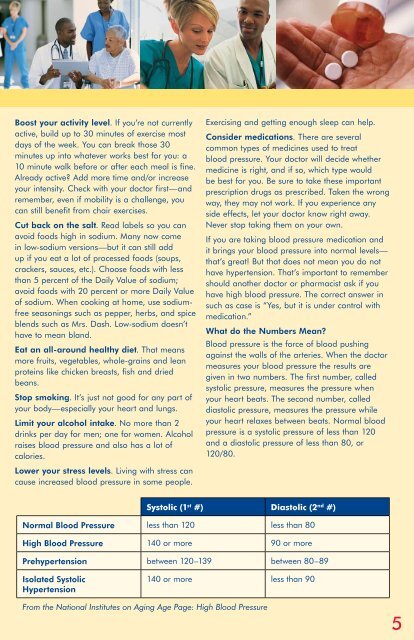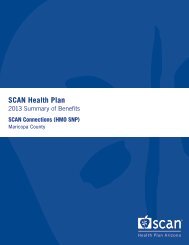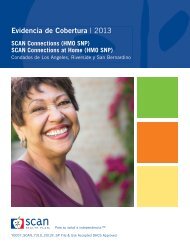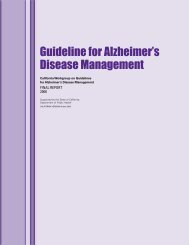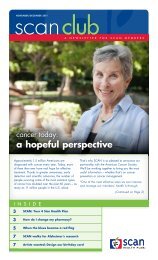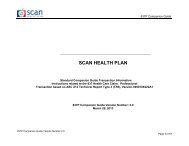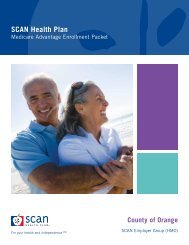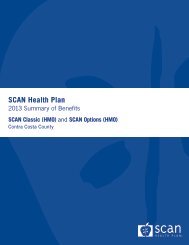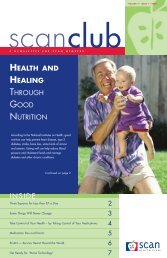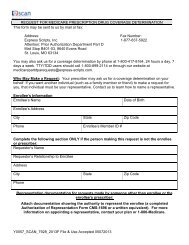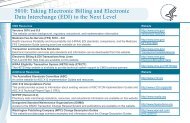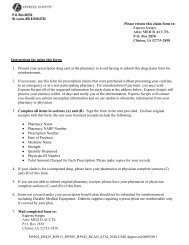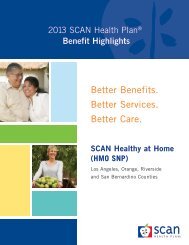Protect Yourself from Scams - SCAN Health Plan
Protect Yourself from Scams - SCAN Health Plan
Protect Yourself from Scams - SCAN Health Plan
Create successful ePaper yourself
Turn your PDF publications into a flip-book with our unique Google optimized e-Paper software.
Boost your activity level. If you’re not currently<br />
active, build up to 30 minutes of exercise most<br />
days of the week. You can break those 30<br />
minutes up into whatever works best for you: a<br />
10 minute walk before or after each meal is fine.<br />
Already active? Add more time and/or increase<br />
your intensity. Check with your doctor first—and<br />
remember, even if mobility is a challenge, you<br />
can still benefit <strong>from</strong> chair exercises.<br />
Cut back on the salt. Read labels so you can<br />
avoid foods high in sodium. Many now come<br />
in low-sodium versions—but it can still add<br />
up if you eat a lot of processed foods (soups,<br />
crackers, sauces, etc.). Choose foods with less<br />
than 5 percent of the Daily Value of sodium;<br />
avoid foods with 20 percent or more Daily Value<br />
of sodium. When cooking at home, use sodiumfree<br />
seasonings such as pepper, herbs, and spice<br />
blends such as Mrs. Dash. Low-sodium doesn’t<br />
have to mean bland.<br />
Eat an all-around healthy diet. That means<br />
more fruits, vegetables, whole-grains and lean<br />
proteins like chicken breasts, fish and dried<br />
beans.<br />
Stop smoking. It’s just not good for any part of<br />
your body—especially your heart and lungs.<br />
Limit your alcohol intake. No more than 2<br />
drinks per day for men; one for women. Alcohol<br />
raises blood pressure and also has a lot of<br />
calories.<br />
Lower your stress levels. Living with stress can<br />
cause increased blood pressure in some people.<br />
Exercising and getting enough sleep can help.<br />
Consider medications. There are several<br />
common types of medicines used to treat<br />
blood pressure. Your doctor will decide whether<br />
medicine is right, and if so, which type would<br />
be best for you. Be sure to take these important<br />
prescription drugs as prescribed. Taken the wrong<br />
way, they may not work. If you experience any<br />
side effects, let your doctor know right away.<br />
Never stop taking them on your own.<br />
If you are taking blood pressure medication and<br />
it brings your blood pressure into normal levels—<br />
that’s great! But that does not mean you do not<br />
have hypertension. That’s important to remember<br />
should another doctor or pharmacist ask if you<br />
have high blood pressure. The correct answer in<br />
such as case is “Yes, but it is under control with<br />
medication.”<br />
What do the Numbers Mean?<br />
Blood pressure is the force of blood pushing<br />
against the walls of the arteries. When the doctor<br />
measures your blood pressure the results are<br />
given in two numbers. The first number, called<br />
systolic pressure, measures the pressure when<br />
your heart beats. The second number, called<br />
diastolic pressure, measures the pressure while<br />
your heart relaxes between beats. Normal blood<br />
pressure is a systolic pressure of less than 120<br />
and a diastolic pressure of less than 80, or<br />
120/80.<br />
Systolic (1 st #) Diastolic (2 nd #)<br />
Normal Blood Pressure less than 120 less than 80<br />
High Blood Pressure 140 or more 90 or more<br />
Prehypertension between 120–139 between 80–89<br />
Isolated Systolic<br />
Hypertension<br />
140 or more less than 90<br />
From the National Institutes on Aging Age Page: High Blood Pressure<br />
5


